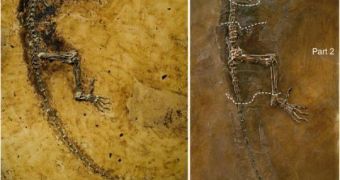A fossil discovered in Germany has the potential to change the way we look at our own evolutionary pattern, its discoverers say. The 47-million-year-old “missing link” is about 20 times older than any of the other preserved remains of our ancestors, and it's also 95 percent complete, which means that anthropologists and archaeologists have a lot of material to work on. The “transactional” animal, named Ida, bears resemblance to non-human evolutionary lines, such as that of prosimians, but also to anthropoids such as monkeys, apes and humans, ScienceDaily reports. The ancient fossil, dating back from the Eocene age (56 to 34 million years ago), was found in the Messel Pit, Germany.
Over the last two years since the animal was found, an international team of scientists has been secretly conducting a very complex series of analyses on Ida, aiming to determine exactly how the species is related to us, or, better yet, what traits we share with the ancient fossil. The effort was led by Dr. Jørn Hurum from the University of Oslo Natural History Museum. The investigator is famous worldwide for his efforts in studying similar finds. “This is the first link to all humans (...) truly a fossil that links world heritage,” he said of the find.
Philip Gingerich, a professor at the University of Michigan Museum of Paleontology, told that, “It’s really a kind of Rosetta Stone.” He is also one of the co-authors of a new study detailing the results of the investigation, which was recently published in the open-access, peer-reviewed journal PLoS ONE, released by the Public Library of Science. The paper also backtracks the road the fossils made around the world since they were first discovered, around 1983. It seems like the “archaeologists” who discovered it split the sample in two, and sold it to different buyers, from the US and Norway.
The PLoS ONE paper was the first one detailing results obtained from studying the full specimen, the researchers added. The creature had opposable thumbs even at that early age, and also large nails at the tip of its fingers. These two traits link it to primates, while a foot bone called the talus bone links it directly to humans. Because of the unique conditions in which the animal was trapped in the deposit after it died, its body outline and guts contained also remained preserved. Anthropologists determined that Ida was a herbivorous animal, feasting on seeds, fruits and other such foods before its death.
According to the researchers, Ida may have died while trying to drink some water from the volcanic lake at the Messel Pit. She already had a broken arm, which was barely healing, and must have fallen unconscious due to the carbon dioxide gas that was coming out of the forming lake. The experts hypothesize that she must have fallen into the lake, and then to the lake floor, where unique conditions kept her preserved for 47 million years.

 14 DAY TRIAL //
14 DAY TRIAL //